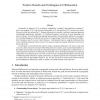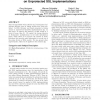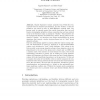25 search results - page 5 / 5 » Public-Key Encryption with Non-interactive Opening |
CISC
2008
Springer
13 years 7 months ago
2008
Springer
Anonymity is one of the main concerns in group-oriented cryptography. However, most efforts, for instance, group signatures and ring signatures, are only made to provide anonymity ...
EUROCRYPT
2004
Springer
13 years 10 months ago
2004
Springer
Informally, an obfuscator O is an efficient, probabilistic “compiler” that transforms a program P into a new program O(P) with the same functionality as P, but such that O(P)...
CCS
2005
ACM
13 years 10 months ago
2005
ACM
Since the remarkable work of Kocher [7], several papers considering different types of timing attacks have been published. In 2003, Brumley and Boneh presented a timing attack on...
WS
2005
ACM
13 years 11 months ago
2005
ACM
Mobile ad hoc networks (MANETs) offer communication over a shared wireless channel without any pre-existing infrastructure. Forming peer-to-peer security associations in MANETs i...
EUROCRYPT
2003
Springer
13 years 10 months ago
2003
Springer
Abstract. Digital Signatures emerge naturally from Public-Key Encryption based on trapdoor permutations, and the “duality” of the two primitives was noted as early as Diffie-He...



